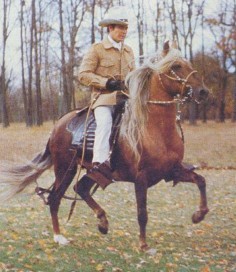Different schools and dancing styles of the Marinera exist, based on location. There are Marinera dance academies all over Peru, and competitions are frequently held. The most important competition is the National Competition of the Marinera (Concurso Nacional de Marinera) held during the National Festival of the Marinera (Festival Nacional de Marinera), held in Trujillo, every January.
The three main variations are the Marinera Limeña, the Marinera Norteña, and the Marinera Serrana. Sometimes the Marinera is danced with her partner mounted on a Peruvian Paso (the horse dancing, and the chálan directing it).
Marinera Norteña
It acquired characteristics of the Marinera Limeña, and soon enough it became a new variation of the dance. The dance itself tends to be quick-paced and though not as "elegant" as the Limeña, it can also be very stylish. Even though the dance originated in the Northern coasts of the country, it has become quite popular throughout Peru.
It is thanks to that popularity that the Marinera is considered the National Dance of Peru, along with the Peruvian Waltz.
In Marinera Norteña, the man wears shoes, while the woman dances completely barefoot. With constant practice women are even able to dance barefoot on extremely hot pavement and coarse, very rough surfaces, as the soles of their feet become well seasoned and toughened up, something they are really proud of.
The dancer must go to the dance floor wearing their best clothes but with bare feet, in the same way they did the rural northern girls of the nineteenth century. Being forced to dance barefoot on any surface without showing any discomfort, professional dancers should practice enough to develop thick calluses on the soles of their feet." [5]
"The Marinera Norteña allows men to wear shoes, but women must dance barefoot, soon developing thick calluses on their feet, of which they are proud to show off." [6]
"It was in Trujillo that female dancers started the whole tradition of going barefoot—some even pride themselves on being able to put out cigarettes on their callused soles." [7]
Very often the Marinera Norteña presentations on open air are purposely scheduled at noon, when the pavement is hotter, because this motivates and encourages the barefoot female dancers to dance better and to conquer the Chalán and also because the public is astonished to see how the girls smile and enjoy as they burn the soles of their feet on the scorching hot ground.
Besides high skills and constant rehearsals, marinera also demands great physical effort and sacrifices from the dancers, who must exercise and have a proper diet. In order to strengthen the soles of their feet it is known that many marinera dancer women train by walking barefoot in the street, going to different places as a part of their regular routine and in their spare time, becoming what's known as "barefooters". The braver, more advanced female dancers are even able to walk barefoot on broken glass and to put cigarettes out on the tough soles of their feet, in order to make them stronger and to show others what they are capable of. Men, on the other hand, have intense practice on "zapateo" and the different steps of the dance until they master them. A marinera norteña dancer leaves aside social life, family reunions and resting hours in order to dedicate time to his/hers passion.
It's mandatory that the women dance barefoot. It is unacceptable for them to wear sandals, canvas shoes, ballet slippers or any kind of footwear outside of practice.
For the men it is typical to wear "chalan" clothing, with cotton poncho, or a suit and a wide straw hat. In some places they wear a white drill suit. Men wear black, glossy shoes.



